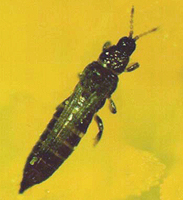|
|
Back to Pest Identification and Diagnosis
COMPOSITE
THRIPS
SCIENTIFIC NAME: Microcephalothrips abdominalis (D.L. Crawford)
CLASS: Insecta
ORDER: Thysanoptera
FAMILY: Thripidae
 |
 |
|
|
Adult Composite Thrips From: Entomological Laboratory |
Adult Composite Thrips From: NC Extension |
| DESCRIPTION | |
|
Adults: Females of this species are yellowish brown to dark brown, and the head is small with black eyes and red ocelli. Intermediate antennal segment, apex of fore femora, and all tarsi lighter, becoming yellow brown to yellow. The forewings are brownish gray. Prothorax longer than wide and moderately covered with setae. Males are smaller and paler than females. Males have a dark brown head and pale yellow body. Eggs: The eggs are yellowish and small, almost spherical (with a slightly narrow anterior end). Eggs average 0.12 mm long and 0.08 mm in diameter. Larvae: The first instar is translucent to whitish yellow and is 0.36 to 0.68 mm long. The second instar is yellow with the head smaller in relation to thorax and abdomen. Body length is 0.68 to 1.0 mm. Pupae and Prepupae: The prepupa is sluggish and moves only when disturbed. It is pinkish yellow and 0.71 to 1.0 mm long. It rests in the outer bracts of the flower or between the lower ends of florets. The pupa is inactive, robust, and pinkish yellow. Male pupae are 0.63 to 0.81 mm and female pupae are 0.89 to 1.4 mm long. |
|
| BIOLOGY | |
|
Distribution: The composite thrips is a new world thrips found throughout most of North America. It is an occasional inhabitant of greenhouses throughout the southeastern United States. Host Plants: Adults and larvae usually are found in the flowers and are rarely found on the foliage. Composite thrips occurs in great abundance on flowers of chrysanthemum, cosmos, zinnia, and marigold. Damage: Heavy infestations cause damage to the corolla, stamens, and developing seed of plants in the Compositae. Petals lose pigmentation, senesce early, and drop prematurely. Life Cycle: The life cycle requires 11 to 13 days at 27° C. Eggs hatch in 72 to 80 hours. The first and second instars last about 3 days each, the prepupal stage requires 24 hours or less, and the pupal stage varies from 24 to 48 hours. Eggs are laid inside the tissue of the disc floret. Females are 15 times more numerous than males. Reproduction is both sexual and parthenogenetic. New females begin to lay eggs 72 to 96 hours after emergence from the pupal stage. |
Back to Pest Identification and Diagnosis
 |
(C) Regents of the University of
Minnesota. All rights reserved. |
 |
 |